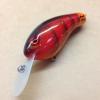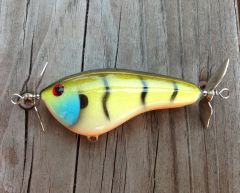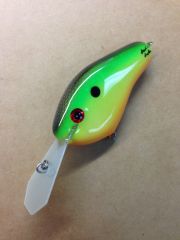-
Posts
140 -
Joined
-
Last visited
-
Days Won
1
Content Type
Profiles
Articles
TU Classifieds
Glossary
Website Links
Forums
Gallery
Store
Everything posted by HAWGFAN
-
The Iwata Neo is as cheap as you'd want to go. There are many sources for it online and through Ebay, so just take a few minutes to shop around. Of course "cheap" can be a relative term. I believe most would agree that you'll be better served with the Iwata Revolution BR, if you can afford it. In the world of quality airbushes, it's very affordable. You'll want a gravity feed, whichever you go with. Createx paints will do well for you. You'll have to experiment with air pressures and reducer to get it to spray the way you like. If you don't have an air supply, a small, nail gun type compressor will do fine. If it doesn't have a regulator, you'll need that as well.
-
I've never experienced blushing with any epoxy that I've tried. However, CA glues that you might use to install bills with can leave a residue while curing. D2T coated baits can usually be gently handled in three hours, at room temperature. After 24 hours, you could essentially consider them "full hard". That's not to say that they'll never get any harder though. In a pinch, I've coated in the afternoon, and fished them the next morning, with good results.
-
Don't use 5 min epoxies for your clear coat. Use the 2 ton (30 min). It should be fine over a coat of Etex. If your Etex didn't cure properly, you may have issues. In that case, I'd strip it and start over. Otherwise, you might give it a quick scuff with a fine sanding sponge, then wipe it down. You'll see lots of solvents mentioned for this step. They're all good for removing any oils that may be present from handling. The one I use, and don't hear about as often is rubbing alcohol. I get the highest concentration I can find, but any would do. If it were to feel damp, just hit it with the hair dryer (or whatever) you use to heat set your paints, but it typically evaporates very quickly. It's readily available, inexpensive, and less hazardous to handle than acetone and some others.
-
Have you tried Devcon 2 ton? It seems to be much more forgiving and harder than Etex. I made the switch and won't go back.
-
I've never looked into at the level you are, but I do sell a few baits as a hobby. I can tell you that making a living at it would be very difficult, for all the reasons Salty mentioned. Possibly the most important being, it's all been done before. There probably isn't a lot of patentable intellectual property left. I suspect that even if you do have some unique quirk to your bait, someone somewhere has done it before. If you did try to mass produce it, it would immediately get copied. Just look at the trends among major brands. One releases something a little different and the rest jump on board within a month or two. Then the next season smaller players go to market with their offering for half the price. Of course, I don't know the specifics of your idea, so I could be completely wrong. I certainly don't know a lot about the industry, nor do I claim to. I also suspect that the business looks more glamorous from afar that it actually is. After a while you may turn what you enjoy into just another job. I'd recommend staying small. You may develop a nice following that would be willing to pay a premium for your bait. If your desire is to make it big in the business, I wish you the best of luck. Everyone got their start somewhere. Who knows, you might be the next big thing. That's what this country was founded on.
-

In Ref To The Topic Posted "epoxy Issues, Pls Help"
HAWGFAN replied to fishnart's topic in Hard Baits
You can get your D2T in the syringe container, and not have to worry about measuring. I've used it this way with good results. I usually mix in disposable aluminum epoxy pans. I press a quarter sized indention in the bottom, which makes it easier to keep small amounts contained. That helps a lot with what RayburnGuy was saying about incorporating everything into the mix. I spray epoxy stripper into the pan when i'm finished, and use it to clean the pan and my brush. Some use disposable brushes. An option to buying the pans, that was mentioned on here recently, is to use the bottom of empty soda/beer cans. It the perfect shape and size. I wish I'd thought of that! -
It also would be a pretty good sunfish pattern. I think it would catch fish in my area. I often use patterns that look similar to a craw or bream. I'm not sure which the fish think they're eating, and as long as it gets bit, I'm not sure I care. I'm also curious about how you did the blue.
-

In Ref To The Topic Posted "epoxy Issues, Pls Help"
HAWGFAN replied to fishnart's topic in Hard Baits
I've tried the "eyeball" method. Sometimes it worked, sometimes not. It's not worth the risk. The best way to measure is by volume, not weight. Use syringes. Mark one for resin, one for hardener, and they'll last forever. If there is a store near you that sells farm supplies, they'll have an assortment of sizes. I'm sure there are many sources, and they're very inexpensive. I like the 3cc type. 3cc's of each will do a heavy coat of epoxy on about 4 bass baits, and that's all you have time for with Devcon. You'll soon be able to judge pretty closely what you'll need, and have little waste. A large syringe will have less resolution in your measuring. Don't get one so fat it won't fit in the bottle either. -
So, by this reasoning, would it be possible to have multiple baits with identical shape, materials and ballast perform effectively but differently by changing the one or more of the other factors such as lip size, shape, angle, lure tie? I routinely use the same body style and ballast weight/location to achieve different diving and action characteristics. These are basic rules of thumb, and there may be some exceptions, but here's my thought process: Shallower-line tie in bait or steeper bill angle, Deeper-line tie in bill or flatter bill angle Tighter Action-flatter bill angle or square bill, Wider Action-steeper bill angle or round bill As you see, some changes can have multiple effects. When you put the line tie in the bill, then that gives you even more freedom to experiment. Bill length and line tie position will have an effect. It's a balancing act to get the depth and action you want. I usually don't get too aggressive with bill length when trying something new. You may wind up with a tighter action than you want, but at least it's a functioning bait that won't blow out. Since this thread is referring to flat baits, they are more forgiving in this area, in my opinion. I've put some really large bills in my flatsides, in what I considered to be fairly aggressive configurations, and they always seem to run true.
-
If I ever decide to upgrade to the Revolution, would I need the BR or CR? I've never used the larger 0.5mm nozzle. I've heard that some people prefer it. Most of the detail work I do on baits involves stencils and masking, so I don't think it would be an issue. It would be nice if it made a difference on how it handled thicker paints.
-
Some attractants are a bit oily, so that might help make your frog slicker. I've even heard of guys spraying baits with Pam, or a similar type of cooking spray. I'm not great at walking a frog either. There are some good articles and videos out there that can help. Trimming the legs properly is a good place to start. The agreed upon technique seems to be to walk it on a slack line. Your really popping your slack, more than actually twitching the frog itself.
-
You've done the right thing in cleaning and ensuring your threads are sealed. The only problem is, that isn't your problem. I can tell you from experience, you've flared your nozzle. This was probably caused from seating the needle too hard. Even if you take care in reassembly, it can happen. I can't speak for other brushes, but the nozzle in the Neo is very soft and thin. If you look closely (and it might require some magnification) you'll notice that end of the nozzle is more parallel than conical, maybe even displaying a slight "trumpet" appearance. Parts are available to fix this though. If yours has some mileage, go ahead and replace the needle while you're at it. Now that you've already gotten it squeaky clean, you'll be reminded how much you enjoyed this brush when it was new, after you make the repair. I believe I got my parts from Chicago Airbrush Supply, but I'm sure many others can help you. I chased my tail for weeks, taking the steps you have, until I finally saw this symptom and fix on a forum somewhere. My hope now is that you can get your parts faster than I did. Availability was an issue at the time.
-
The Pebble's bodies look pretty nice. Did anyone find where they actually claimed what type of wood they use? Any balsa dense enough to be directly painted, as they claim, wouldn't be very "cream colored", I wouldn't believe. Anytime I've received a harder piece it's fairly reddish. Basswood or poplar maybe?
-
-
I can't speak for the big swim baits, as I'm not sure the muddy water I usually fish is the best place to use them. I have seen an increase in quality when increasing the size of crankbaits I throw, especially in the summer. I had always gotten a lot of bites on a 2" crank that had a smaller profile, but seldom caught any size. I stepped up to a 1.5 squarebill (not much longer, but larger profile), and started catching more size. I've since started using a 3" bait I carve, that's pretty similar to a B3. It's tons bigger than what I used to use, as far as crankbaits go. I consistently catch more weight, and surprisingly, I don't feel like I've given up many bites. It's also interesting how the smaller fish attack the larger baits. It's as if they know that they have to crush it to have a chance a disabling a larger prey.
-
I've used the bills that Barr mentioned. The one in this image is the large sized one (010). This bait dives to around 10 feet on an average cast, with 12lb line. For smaller sizes you might want to buy square bills, and clip the corners off. This is a balsa flatside, around the same size that you are interested in. Notice, it would require you putting the line tie in the bill. It's not terribly difficult, but you might want to try some with the tie in the bait first.
-
So many variables to this question! All I can give you are generalities from my experiences, and others might not necessarily agree. That's the beauty of it. Everybody does things their own way, and may achieve different results from similar components. I'll first assume the line tie is directly in the nose of the bait. Your target depth is going to be about the max I'd expect from this configuration. I'd start with a bill that is 7/8" to 1" at its widest point. I'd leave 3/4" to 7/8" of bill exposed beyond the body of the bait, and install the bill at about a 20 degree angle. That should get you a bait that is forgivingly stable, but with decent action. I'd use a 5 gram belly weight. I think 6 feet from something inside those parameters would be achievable. 8 might be a stretch, especially on a short cast. To reliably get more depth, the easiest thing to do is install the line tie in the bill. Get your feet wet with these first.
-
Basswood might be interchangeable with Poplar, but it would probably be approaching three times the density of Balsa. Most of the Pines that I can find listed are in this same range. Western Red Cedar is a wood that would be consistently lighter than the others mentioned, still double the weight of Balsa. BobP said it, if you buoyant, Balsa is king. It is available in many different shapes from hobby stores. What you'll get will typically be on the softer side, and considered to be around 9# density I believe. This is what I prefer, because it's easy to work with. Some guys like 12#, but you'll pay extra for it, if you can find a dealer that will grade it out. On occasion I'll receive a board with a reddish tint. These are harder, so I use them for one piece flatside baits that require less sanding.
-
If time allows, give the balsa a try. Don't let the light weight fool you. By the time you get it sealed, coated, and say 5 grams of ballast, you'll have no problem casting it. I'd be interested to know how the action differs from one of your poplar baits, with the same bill configuration. I like the ease of working with balsa, so I've never experimented with the harder woods.
-
I've often suspected my paint not being fully cured as another culprit. I seem to have less fish eyes if I let the bait sit for a day before clear coating. I use Createx, and some colors seem really hard to set with a hair dryer. They are designed to set on fabric with an iron. I'm also prone to using thicker layers than I should at times, which makes it harder to cure. Heat as best you can between layers, even of the same color, then wait a day or two. That might help.
-
I'm glad BobP mentioned his wire installation technique. I do the same thing on my round bodies baits. They are made from two 1/2" pieces of balsa. I make flatside baits from one 1/2" piece, and use the steps mentioned above. I've yet to have a failure with either. Putting components in a two piece bait does take a little longer, but I'm a hobby builder that isn't interested in much volume. My customers understand this and are fine with the lead time. So far, I just make all my baits to order. I can see how time savings would help if you were trying to make a lot of baits to try and sell later, or took large orders.
-
No need for the dowel on the hangers. I use a medium CA, instead of epoxy. Instead of drilling the hole for the twisted wire, I just press in the hole with a metal BBQ skewer that is a little larger diameter than hanger. It shouldn't really matter how you make your holes. I just like to use hand tools. The only thing I use a power tool for is to cut out the shape, and cut the bill slot with a scroll saw. He clipped the wire because it was a bit long. I intentionally leave mine 1/4" long, or so. It presses easily into the wood, and should carry some glue with it. That's just preference, not necessary I'm sure. I try to get as much glue as I can to run into the hanger hole, coat my wire, then press it in. If you have doubts, do a test run on scrap piece of balsa. The wood will fail before the hanger pulls out. As for the enamel...I think most would recommend a sealer that does more to harden the balsa. I use propionate, or epoxy. Many here use thin CA. I'm sure the enamel is a fine sealer. I just like to have something more resistant to rocks, in the event of a top coat failure. That could help you finish the day without water-logging your favorite bait. You don't have to give up on a hot bite, and you can repair the paint and top coat later.
-
I've caught a lot of fish on the 1.5, but prefer the 2.5 any time after the spawn. I use the silent or DRS types, not the rattling versions. To me, they're too loud. Predator has good ones. In the 2.5, the WT models seem to run better for me. As long as you stick with domestic sources on Ebay, you should be fine. I've tried some from foreign suppliers. The quality seemed satisfactory, but they had the free ball rattle, which I don't like. You usually don't get much detail from those guys, so you can't be sure what you're getting.
-

Question On Scales, Not Fish Scales, But Weight Scales
HAWGFAN replied to bassguy's topic in Hard Baits
Most digital scales that are used for reloading ammo will display grains and grams. You could convert to ounces if that isn't available. There are free cell phone apps that will do the calculation for you. Some of these type scales are getting pretty affordable. I've seen some simpler models for around $30, such as the Frankford Arsenal DS-750, from Midway USA. You could probably find some used ones on eBay. I don't have any experience with postage scales.





